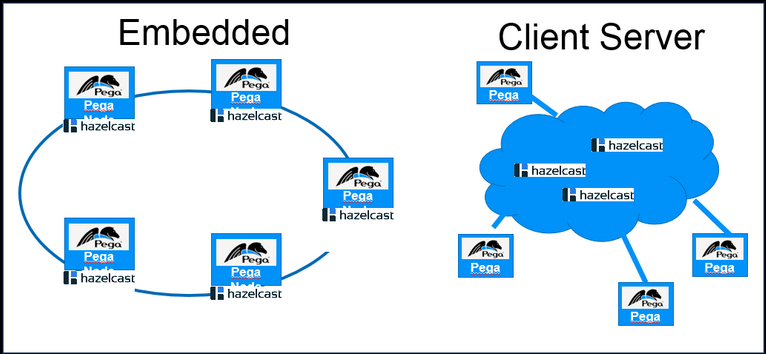
Cluster topologies
Horizontal and vertical cluster topologies
Pega Platform™ is most often deployed as a traditional JEE application, running within a JVM inside an application server.
Pega engines can be scaled vertically or horizontally and are typically deployed in conjunction with a load balancer and other infrastructure resources such as proxy and HTTP.
Note: Load balancers must support session affinity for users who are leveraging the Pega UI. Service clients can invoke Pega using either stateless or stateful sessions.
Horizontal scaling means that multiple application servers are deployed on separate physical or virtual machines.
Vertical scaling means that multiple Pega Platform™ servers are deployed on the same physical or virtual machines by running them on different port numbers. Pega Platform™ natively supports a combination setup that uses both horizontal and vertical clusters.
A cluster may have heterogeneous servers in terms of hardware and operating system. For instance, some servers can use Linux, and others can use Windows. Usually, the only restriction is that all servers in a cluster must run the same Pega Platform™ version. Pega Platform™ engines can be deployed across heterogeneous platforms as shown here.
For example, a collection of WebSphere nodes can be used to support a human user community and a Jboss node can be deployed to handle low-volume service requests made by other applications. The Pega Platform™ engine can also be deployed on zSeries mainframes. This flexible deployment model allows Pega customers to build a process once, and deploy it seamlessly across multiple platforms and channels without redesigning or rebuilding the process each time.
In-memory cache management options for multi-node cluster topologies
Pega Platform™ supports an in-memory cache management option for multi-node cluster topologies: Hazelcast running in Embedded or Client Server mode.
| Option | Embedded | Client-Server |
|---|---|---|
| Hazelcast | Default | Supported |
Hazelcast
Hazelcast is embedded in the Pega Platform™ and is the default in-memory cache management option or in-memory data grid used by Pega Platform™ in multi-node cluster topologies.
Hazelcast is an open source in-memory data grid based on Java. In a Hazelcast grid, data is evenly distributed among the nodes of a cluster, allowing for horizontal scaling of processing and available storage. Hazelcast can run embedded in every node but also supports a client-server topology.
Hazelcast Client-Server
Pega Platform™ can use Hazelcast in client-server mode for in-memory cache management.
Hazelcast in client-server mode is an in-memory cache management platform that can provide greater speed and scalability in large multi-node clusters. Hazelcast supports high-performance transactions, real-time streaming, and fast analytics in a single, comprehensive data access and processing layer.
Hazelcast supports client-server mode. Client-server mode provides greater cluster stability in large clusters and supports the ability for servers and clients to be separately scaled up. Use client-server mode for large production environments that consist of more than five cluster nodes or if you experience cluster instability in clusters that contain fewer nodes. The number of nodes in the cluster that can lead to cluster instability depends on your environment, and switching to client-server mode is determined individually.
Client-server mode is a clustering topology that separates Pega Platform™ processes from cluster communication and distributed features. Client-server mode clustering technology has separate resources and uses a different JVM from the Pega Platform™. The client nodes are Pega Platform nodes that perform application jobs and call the Hazelcast client to facilitate communication between Pega Platform™ and the Hazelcast servers. The Servers are stand-alone Hazelcast servers that provide base clustering capabilities, including communication between the nodes and distributed features. At least three Hazelcast servers are required for one cluster.
The client-server topology adds value to the business by providing the following advantages:
- The cluster member life cycle is independent of the application life cycle since nodes are deployed as separate server instances.
- Cluster performance is more predictable and reliable because cluster components are isolated and do not compete with the application for CPU, memory, and I/O resources.
- Identifying the cause of any unexpected behavior is easier because cluster service activity is isolated on its own server.
- A client-server topology provides more flexibility since clients and servers can be scaled independently.
For more information about deploying the Pega Platform™, see Deploy Pega Platform. For more information about enabling client-server mode, see Managing clusters with Hazelcast.
If you are having problems with your training, please review the Pega Academy Support FAQs.
Want to help us improve this content?


